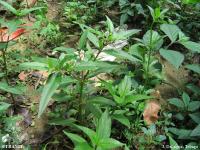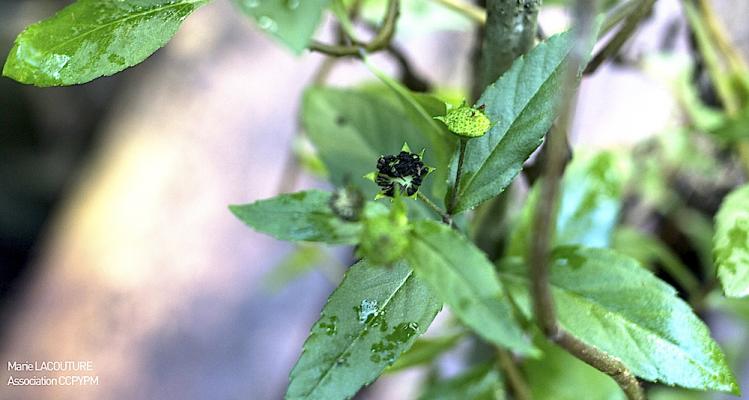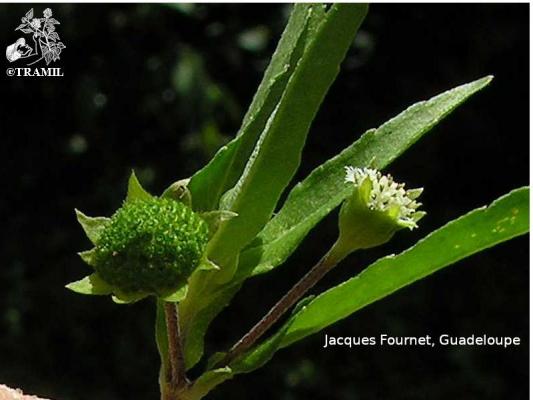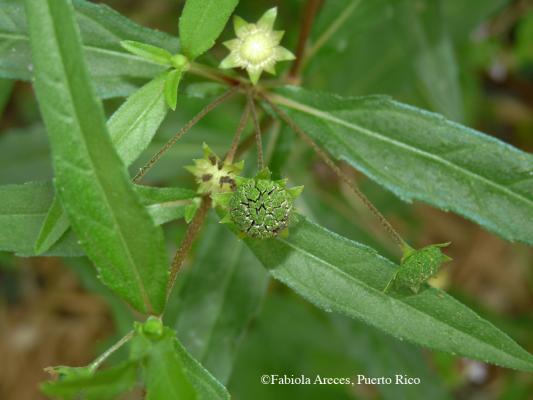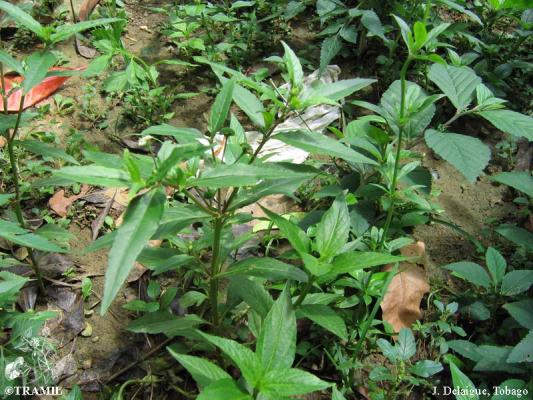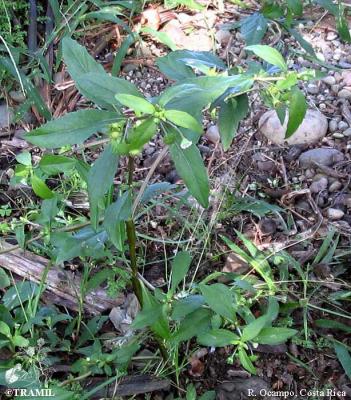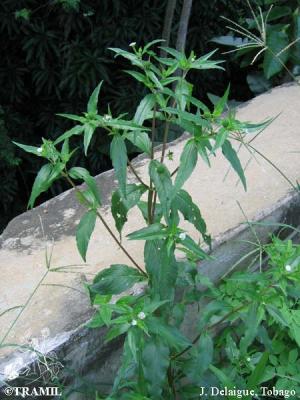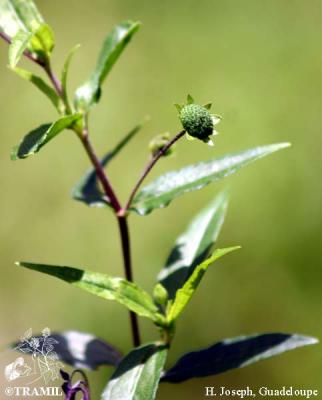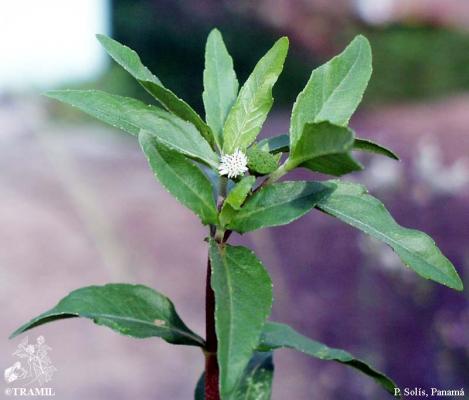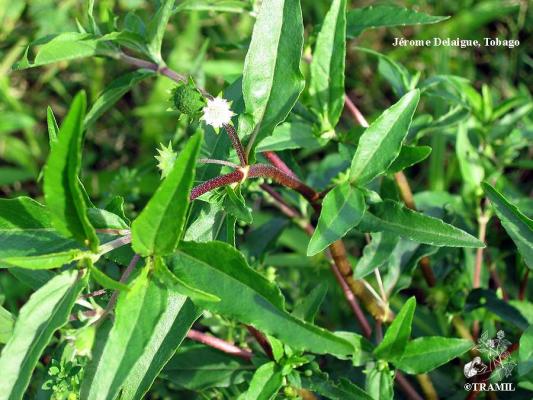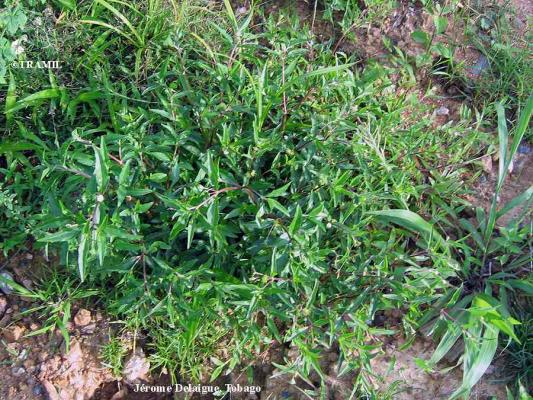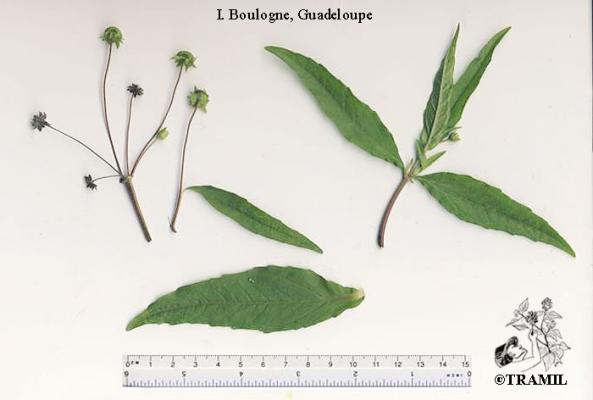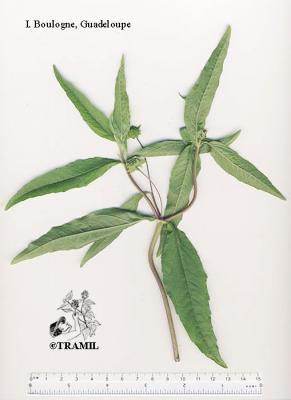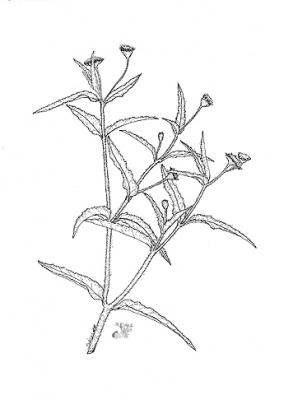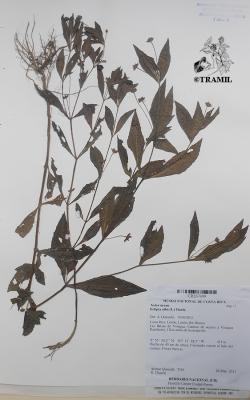Eclipta prostrata
Distribution géographique
Apparemment originaire du Nouveau Monde, actuellement largement répartie dans les champs de culture des deux hémisphères.
Description botanique
Herbe dressée ou rampante, annuelle ou à vie courte. Feuilles opposées, simples, de presque 7 cm de longueur, elliptiques à lancéolées, effilées à la pointe. Inflorescences terminales parfois axillaires; petits capitules de 3-9 mm, transversalement disposés en rayons, bractées involucrées 8-9, imbriquées; fleurs blanches. Akène dont la surface supérieure et inférieure est compressée, formant des angles très nets, légèrement ailé.
Voucher(s)
FLORPAN,1932,PMA
Pharmacopée
Ed.3References
1 SOLIS P, CORREA M, GUPTA M, 1995
Encuesta TRAMIL (Comunidades afro-caribeñas). Centro de Investigaciones Farmacognósticas de la Flora Panameña CIFLORPAN, Facultad de Farmacia, Universidad de Panamá, Panamá, Panamá.
2 GOVINDACHARI TR, NAGARAJAN K, PAI BR, 1956
Wedelolactone from Eclipta alba. J Sci Ind Res-B 15:664-665.
3 BHARGAVA K, KRISHNASWAMY N, SESHADRI T, 1970
Isolation of demethyl wedelolactone and its glucoside from Eclipta alba. Indian J Chem 8(7):664-665.
4 SARG T, ABDEL SALAM N, EL-DOMIATY M, KHAFAGY S, 1981
The steroid, triterpenoid and flavonoid constituents of Eclipta alba (L.) Hassk. (Compositae) grown in Egypt. Sci Pharm 49:262-264.
5 WAGNER H, GEYER B, KISO Y, HIKINO H, RAO GS, 1986
Coumestans as the main active principles of the liver drugs Eclipta alba and Wedelia calendulacea-1. Planta Med 5:370-374.
6 BOHLMANN F, ZDERO C, 1970
Polyacetylene compounds. Part 173. Constituents of Eclipta erecta. Chem Ber 103:834-841.
7 SINGH P, 1988
Naturally-occuring thiophene derivatives from Eclipta species. Bioact Mol 7:179-186.
8 SINGH P, SHARMA A, JOSHI K, BOHLMANN F, 1985
A further dithienylacetylene from Eclipta erecta. Phytochemistry 24(3):615-616.
9 KRISHNASWAMY N, SESHADRI T, SHARMA B, 1966
Synthesis of alpha-terthienylmethanol, a component of Eclipta alba. Curr Sci 35(21):542.
10 JAIN S, SINGH P, 1988
A dithienylacetylene ester from Eclipta erecta Linn. Indian J Chem Ser B 27(1):99-100.
11 LIU QM, ZHAO HY, ZHONG XK, JIANG JG, 2012
Eclipta prostrata L. phytochemicals: isolation, structure elucidation, and their antitumor activity. Food Chem Toxicol 50(11):4016-4022.
12 PAL S, NARASIMHAM N, 1943
The alkaloid in Eclipta alba (Hassk). J Indian Chem Soc 20:181-186.
13 ZOU J, UCHIYAMA M, 1993
Chemical constituents of yerbadetajo (Eclipta prostrata). Chung Ts'ao Yao 24(4):174-176.
14 DEBELMAS A, HACHE J, 1976
Toxicity of several medicinal plants of Nepal including some behavioral and central nervous system effects. Plant Med Phytother 10:128-138.
15 Tewtrakul S, Subhadhirasakul S, Tansakul P, Cheenpracha S, Karalai C, 2011
Antiinflammatory constituents from Eclipta prostrata using RAW264.7 macrophage cells. Phytother Res: 10.1002/ptr.3383.
16 SINGH B, SAXENA K, CHANDAN B, AGARWAL S, BHATIA M, ANAND K, 1993
Hepatoprotective effect of ethanolic extract of Eclipta alba on experimental liver damage in rats and mice. Phytother Res 7(2):154-158.
17 DHAR ML, DHAR MM, DHAWAN BN, MEHROTRA BN, RAY C, 1968
Screening of Indian plants for biological activity: part I. Indian J Exp Biol 6:232-247.
18 JAYARAM S, THYAGARAJAN S, PANCHANADAM M, SUBRAMANIAN S, 1987
Anti-hepatitis-B virus properties of Phyllanthus niruri Linn. and Eclipta alba Hassk: in vitro and in vivo safety studies. Bio-Medicine 7(2):9-16.
19 CHANDRA T, SADIQUE J, SOMASUNDRARAM S, 1987
Effect of Eclipta alba on inflammation and liver injury. Fitoterapia 58(1):23-32.
20 SAXENA A, SINGH B, ANAND K, 1993
Hepatoprotective effects of Eclipta alba on subcellular levels in rats. J Ethnopharmacol 40(3):155-161.
21 DIXIT S, ACHAR M, 1981
Study of bhringaraja (Eclipta alba) therapy in jaundice in children. J Sci Res Pl Med 2:96-100.
22 ANON 1982
A trial of bhringaraja ghanasatwavati on the patients of Kostha-shakhasrita Kamala (with special reference to hepatocellular jaundice). J Natl Integ Med Assoc 24(9):265-269.
23 PRAKASH A, PASALU IC, MATHUR KC, 1979
Ovicidal activity of Eclipta alba Hassk. (Compositae). Curr Sci 48:1090.


